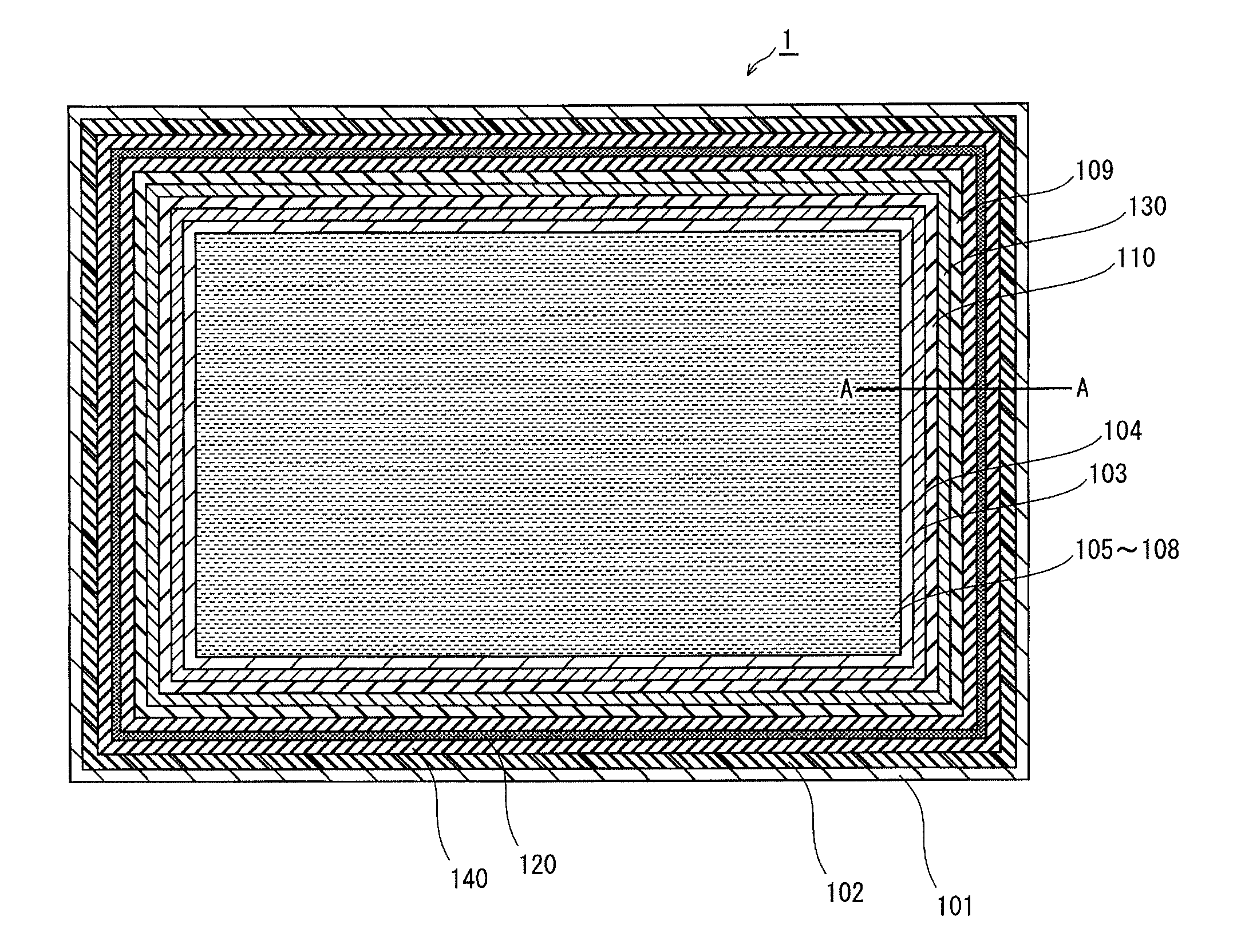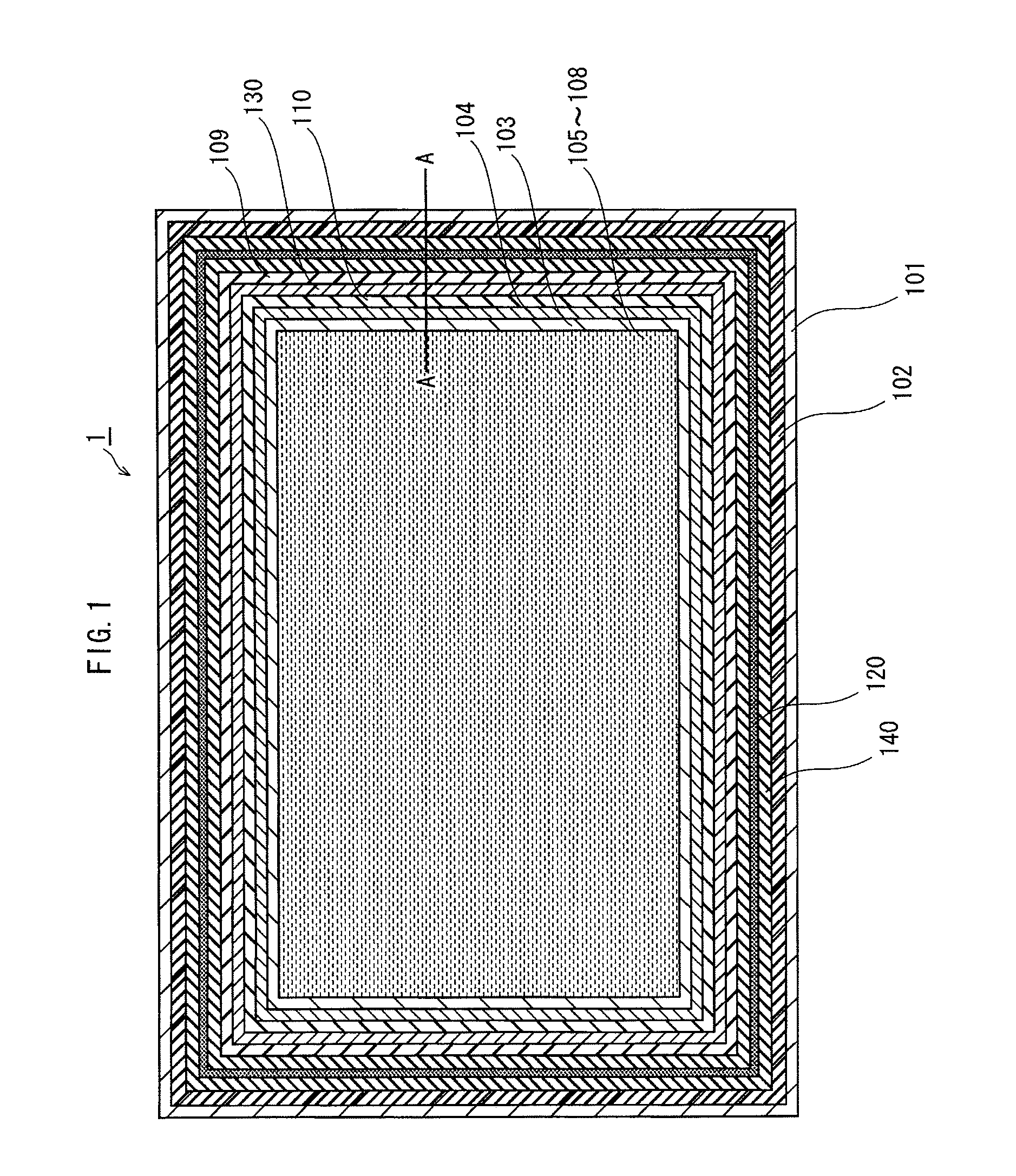Display panel and production method thereof
a technology of display panel and production method, which is applied in the field of display panel, can solve the problems of significant deterioration of the characteristics of organic el elements, high active and unstable laminate, and increase and achieve the effect of improving the strength of the bonding between the first substrate and the second substrate, reducing the amount of bubbles remaining inside the glass frit, and increasing the strength of the hermetical seal
- Summary
- Abstract
- Description
- Claims
- Application Information
AI Technical Summary
Benefits of technology
Problems solved by technology
Method used
Image
Examples
exemplary embodiment 1
Modifications Etc. of Exemplary Embodiment 1
[0220](1) FIG. 9 is a front view of an organic EL display panel 1 according to a modification of the exemplary embodiment 1 of the present disclosure. The structure of the organic EL display panel 1 according to this modification is basically the same as the organic EL display panel 1 according to the exemplary embodiment 1 shown in FIG. 2, except that no thin encapsulating layer 109 is provided on the cathode 108.
[0221]The method for manufacturing the organic EL display panel 1 shown in FIG. 9 is basically the same as the manufacturing method described above, except that the process of forming the thin encapsulating layer 109 is not included.
[0222]Features of the light-shielding part 140 and the resulting effect of increasing the sealing strength of the glass frit part 120 and the bonding strength between the EL substrate 2 and the CF substrate 3 remain the same as described above.
[0223](2) In the exemplary embodiment 1 described above, t...
exemplary embodiment 2
[0237]In the exemplary embodiment 1 described above, the glass frit is subjected to laser irradiation through the light-shielding part 140 in the pre-baking process as well as in the final baking process. In an exemplary embodiment 2, the light-shielding part 140 is not used to cause a temperature gradient in the glass frit. Instead, the spot diameter and path of the laser beam used for irradiating the glass frit is adjusted to cause a temperature gradient in which the temperature of the glass frit is higher in the outer region.
[0238]The structure of the EL substrate 2 and the glass frit paste 120a are similar to that described in the exemplary embodiment 1. The CF substrate 3 is also similar to that described in the exemplary embodiment 1, except that no light-shielding part 140 is provided.
[0239]In the same manner as described in the exemplary embodiment 1, the process of applying glass frit, the process of joining substrates, and the process of UV irradiation and thermal curing a...
exemplary embodiment 3
Modifications Etc. of Exemplary Embodiment 3
[0351](1) FIG. 23 is a front view of an organic EL display panel 1 according to a modification of the exemplary embodiment 3 of the present disclosure. The structure of the organic EL display panel 1 according to this modification is basically the same as the organic EL display panel 1 according to the exemplary embodiment 3 shown in FIG. 17, except that no thin encapsulating layer 109 is provided on the cathode 108.
[0352]The method for manufacturing the organic EL display panel 1 shown in FIG. 23 is basically the same as the manufacturing method shown described above, except that the process of forming the thin encapsulating layer 109 is not included.
[0353]Features of the heat-conducting layer 240 and the resulting effect of increasing the strength of sealing the bonding strength of the EL substrate 2 and the CF substrate 3 by the glass frit part 120 remains the same as described above.
[0354](2) In the exemplary embodiment 3 described abo...
PUM
| Property | Measurement | Unit |
|---|---|---|
| thickness | aaaaa | aaaaa |
| viscosity | aaaaa | aaaaa |
| diameter | aaaaa | aaaaa |
Abstract
Description
Claims
Application Information
 Login to View More
Login to View More - R&D
- Intellectual Property
- Life Sciences
- Materials
- Tech Scout
- Unparalleled Data Quality
- Higher Quality Content
- 60% Fewer Hallucinations
Browse by: Latest US Patents, China's latest patents, Technical Efficacy Thesaurus, Application Domain, Technology Topic, Popular Technical Reports.
© 2025 PatSnap. All rights reserved.Legal|Privacy policy|Modern Slavery Act Transparency Statement|Sitemap|About US| Contact US: help@patsnap.com



